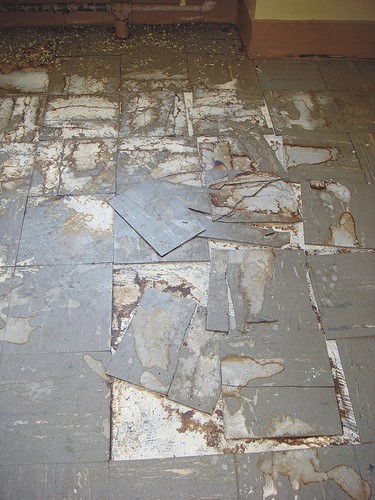
Recently, Guardian Group, Inc.’s Construction Defect Group was dispatched to the scene of a commercial structure that housed the local Girl Scout Council. Our construction defect experts were asked to investigate a reported popping of tiles at the site, complete a failure analysis and prepare a report documenting the forensic causation. The single-story, concrete masonry unit (CMU) building was originally constructed in 1963 and was remodeled in 1982. On-site inspection of the interior facilitated creation of a color-coded sketch. The sketch was used to show the various locations of tenting tiles, debonded tiles and previously replaced tiles.
Guardian’s construction defect expert analysis and final report included the following findings:
First, when tile is applied to a concrete substrate, mortar is used to adhere the ceramic, but it is essential that both tile and floor are free of contaminants. Inspection revealed that deposits of the original adhesive from before the remodel, had been left behind on the concrete. This hindered the mortar’s ability to resist uplift.
Second, the Tile Council of North America (TCNA), publishes guidelines regarding thermal expansion and the need for movement joints. Guardian Group, Inc.’s thorough inspection found no movement joints had been installed. As an attachment to the final report, our experts demonstrated the exact locations of where each of the four movement joints should have been placed.
Third, aluminum window framing components, commonly used for sliding doors expand four times more than ceramic tile. For this reason, the rigid grout that had been installed, which was, discovered in the inspection process directly transferred the expansion force. Silicone movement joints should have been at these interfaces to mitigate the impact thermal expansion that would exert on the ceramic tiling.
In total, seven areas of installation-related defects were highlighted and fully documented in the final Forensic Findings Report. Leveraging Guardian Group, Inc.’s nearly 30 years’ experience in construction claims, attorneys and carriers who appreciate our ability to rapidly deploy just the right resources, expediently and cost-effectively. In this case, the carrier-client specifically thanked us for the clear and concise manner with which we delivered our findings, first verbally, and then in the official report.
From classification and causation to culpability and cure, Guardian’s Construction Defect Group is here not only to offer our expertise, but to help streamline your caseload. When construction defect cases, claims and issues cross your desk, we invite you to experience the difference our experience makes.
